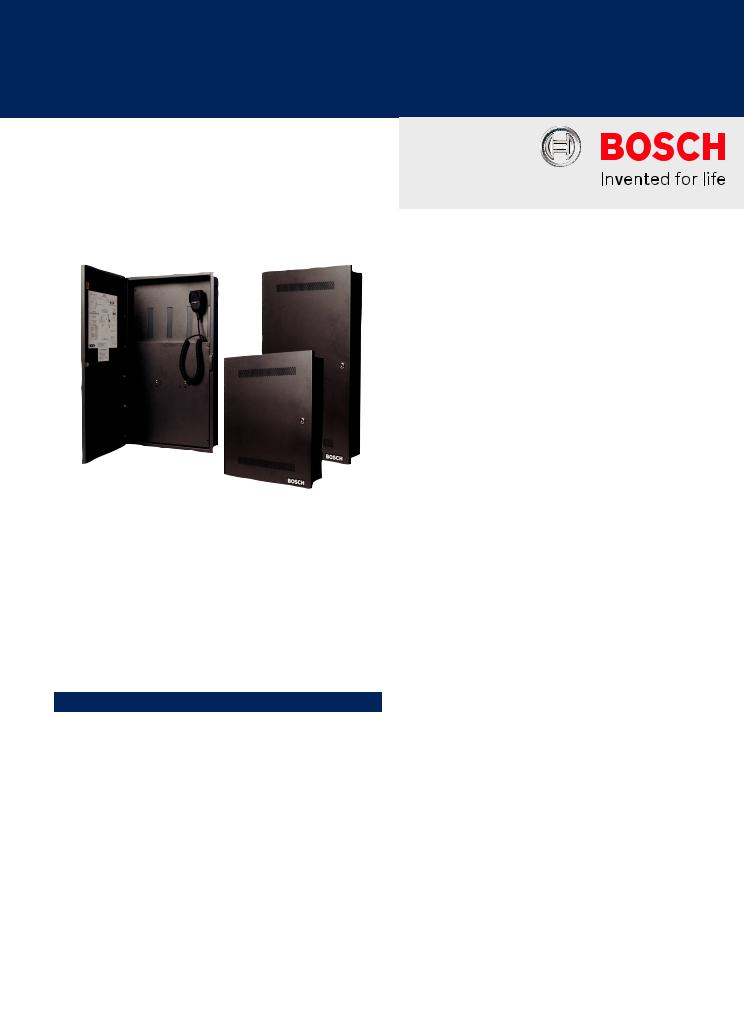Bosch EVAX100-8ZA, EVAX100-8Z, EVAX100, EVAX25-2ZA, EVAX200ER Specsheet
...
Fire Alarm Systems | Bosch Voice Evacuation Systems
Bosch Voice Evacuation Systems
www.boschsecurity.com
The Bosch Voice Evacuation systems and expansion panels provide a variety of options that can be easily added to an existing fire alarm control panel system for area of assembly applications and for high rise voice evacuation not requiring firemens' phones. Choose up to 2000 W of audio amplifier power to meet your speaker power requirements. You can supervise multiple zones through your choice of zone splitters.
System overview
BOSCH Voice Evacuation Systems
All Bosch voice evacuation systems include all the necessary features to provide an effective voice evacuation system:
•Audio amplifier
•Digital message repeater (DMR)
•120 VAC power transformer and battery charger
•Tone generator
•Paging microphone
•Surface mount or semi flush mount enclosure with a hinged, key locked door in charcoal gray (standard) or red (optional)
The EVAX25, EVAX50, and EVAX100 respectively provide 25 W, 50 W, and 100 W of audio amplifier power in a standard size enclosure. The EVAX150 has
uDigitally recorded automatic evacuation message (up to 4 minutes of message capacity)
uAlarm and alert signals
uLive microphone override of message and tone
uCompatible with 12 V or 24 V, analog addressable or microprocessor based fire alarm control panels (FACPs)
uClean dead front construction
one 50 W audio amplifier and one 100 W audio amplifier in a double size enclosure. The EVAX200 has two 100 W amplifiers in a double size enclosure. Customize these systems to satisfy most application requirements by adding expander panels, expander modules, or zone splitters. Expanders can be grouped together in any combination to provide up to 2000 W of audio power.
Optional Expander Panels
The Bosch system expander panels provide an easy and cost-effective way to increase the output power of a Bosch voice evacuation system. They can also provide a manually activated emergency paging panel for buildings. Features of the EVAX25E, EVAX50E, and EVAX100E:
•Audio amplifier
•120 VAC power transformer and battery charger
•Tone generator
•Paging microphone
•Standard size enclosure with a hinged, key locked door
The EVAX150E and EVAX200E expander panels provide the same features with additional power in a double size enclosure housing two amplifier modules.

2 | Bosch Voice Evacuation Systems
Use the EVAX25EM, EVAX50EM, or EVAX100EM expander panel when a 25 W, 50 W, or 100 W audio expander is needed with its own enclosure. Use the EVAX150EM and EVAX200EM for expansion when greater power is required in the larger enclosure configuration. The EM models have all the features of the E models except they are without a paging microphone.
Optional Expander Modules
The expander modules (EVXmodels) can increase the capacity of any Bosch voice evacuation system or expander panel. They do not have paging microphones and are intended for installation in UL Listed enclosures (not supplied). Features of these modules:
•Audio amplifier
•Power regulator and battery charger
•Tone generator
Optional Zone Splitters
The EVX 4Z and EVX 2ZA zone splitters allow the supervised output of any Bosch audio amplifier to supervise multiple zones. Features of these zone splitters:
•Manual selection of any or all voice evacuation zones for emergency paging
•Automatic selection of voice evacuation zones by connecting normally open contacts from the FACP or other auxiliary control system
•Annunciation of either active or faulted zone status by individual LEDs
•Compatibility with jumper selectable 25 V and 70 V amplifier outputs
The EVX 4Z has four Class B zones. The EVX 2ZA has two Class A zones.
Functions
Digital Message Repeater
Each of the Bosch voice evacuation systems (EVAX25, EVAX50, EVAX100, EVAX150, and EVAX200) includes a digital message repeater (DMR). The systems come with the following standard 15 second message programmed:
"Attention, please. There has been a report of an emergency. Proceed calmly to the nearest exit and leave the building immediately. Do not use the elevators; use stairwells where necessary. All handicapped occupants shall use the building evacuation plan."
The voice evacuation message is broadcast until the FACP resets or until emergency personnel interrupt the broadcast with a manual page. When the FACP resets, the voice evacuation system automatically returns to normal operating condition.
The closure of a contact from either the FACP or from any normally open contact device can cause the broadcast of a chime tone followed by the message "All clear."
Optional primary and secondary messages are available. For further information, refer to the Bosch Voice Evacuation System's Optional Messages Technical Service Note (P/N: F01U500869).
Remote Paging Microphones
Remote paging microphones (up to five per EVX SC supervisory card) are supported through a supervised circuit. Remote microphones may be mounted up to 5000 ft (1.5 km) away from the EVAX voice evacuation panel. An ideal use for a remote microphone is when the FACP and voice evacuation system panels are in an electrical room and you need a microphone in the lobby.
System Settings
Control system operation by DIP switch settings:
•Configure three DIP switches to determine alert tones of Temporal Slow Whoop (default), Hi Lo, Horn, Bell, or 1 kHz.
•Turn the Diagnostic Mode on or off (default).
•Set the AC Power Failure Report for no delay (default) or for a six hour delay.
•Indicate if batteries are connected to the system. The default setting is batteries are connected.
•Indicate if a microphone is connected to the system. The default setting is a microphone is connected.
•Set the initial delay before a message starts for no delay, 4 second delay, 8 second delay (default), 12 second delay, 16 second delay, 20 second delay, 24 second delay, or 28 second delay. The chosen tone sounds during the delay.
•Set the delay between repeats of the message for a 4 second delay, 8 -second delay, 12 second delay (default), or 16 second delay.
•Indicate if the message plays or not. Message on is the default.
•Set the number of times the message plays to one play, two plays, three plays (default), or continuous play.
Certifications and approvals
Region |
Certification |
|
|
|
|
USA |
UL |
UOXX: Control Unit Accessories, System |
|
|
(UL864), UOXX2: Control Unit Accesso- |
|
|
ries, System - Component (UL864) |
|
CSFM |
6911-1446:0100 |
|
CSFM |
6912-1446:0101 |
|
|
|
Installation/configuration notes
Compatible Products
The following products are compatible with the Bosch Voice Evacuation Systems:
Category |
Product |
Expansion |
EVX 25 25 W Amplifier with DMR and microphone |
Modules |
|
|
EVX 25E 25 W Amplifier without DMR, with |
|
microphone |

3 | Bosch Voice Evacuation Systems
EVX 25EM 25 W Amplifier without DMR and microphone
|
EVX 50 50 W Amplifier with DMR and microphone |
|
EVX 50E 50 W Amplifier without DMR, with |
|
microphone |
|
EVX 50EM 50 W Amplifier without DMR and |
|
microphone |
|
EVX 100 100 W Amplifier with DMR and microphone |
|
EVX 100E 100 W Amplifier without DMR, with |
|
microphone |
|
EVX 100EM 100 W Amplifier without DMR and |
|
microphone |
Remote |
EVX RM Charcoal gray Remote Microphone Panel |
Microphones |
|
|
EVX RMR Red Remote Microphone Panel |
Zone |
EVX 2ZA Class A Zone Splitter |
Splitters |
|
|
EVX 4Z Class B Zone Splitter |
Speaker Placement
Choose speakers that deliver a minimum ambient sound of 15 dB above the normal ambient noise level. In high ambient noise areas, speakers should be tapped at 15 dB to 21 dB above the ambient noise level and placed closer to one another to ensure that voice messages are intelligible.
The best way to determine speaker placement needs is to conduct a site survey with a decibel meter to measure ambient noise levels; however, some general rules for speaker placement are:
•Locate speakers at all pull stations and in main corridors similar to the layout of conventional fire horns.
•Ensure that all occupied locations are within 50 ft (15 m) of a speaker. Place additional speakers in rooms such as cafeterias and computer rooms. Be sure there are speakers in isolated areas where service personnel might be working.
•For ceiling mount speakers, use 2 W of speaker power for every 2000 ft2 (186 m2) of area covered in open areas and 2 W for every 1500 ft2 (139 m2) in divided areas. For wall mount speakers, use 1 W of speaker power for every 2000 ft2 (186 m2) of area covered in open areas and 1 W for every 1500 ft2 (139 m2) in divided areas.
Speaker Power Requirements
System power (total wattage) must be sufficient to supply the power required by all of the speakers on the system. Speaker transformers can often be tapped for different wattages (usually, ¼ W, ½ W, 1 W, etc.). A system rated at 25 W of audio power can power a speaker load of 25 W. This can be made up of 25 speakers each tapped at 1 W, 50 speakers each tapped at ½ W, or any mathematical combination that is less than or equal to 25 W.
Speaker Wiring Requirements
The 25 V speaker circuits of most voice evacuation systems are classified as power limited wiring and can be run with other fire alarm wiring without ill effects. No special cabling is required. Standard power limited fire alarm cable (FPL) is sufficient for most applications; however, certain addressable systems can generate extraneous noise from their addressable loop. Because these addressable systems cannot use shielded cable, shielding of the evacuation speaker circuit helps to eliminate noise picked up and heard in the speakers. When using 70 V circuits, separate them as described in the National Electrical Code. Generally, 18 AWG (1.0 mm) wire is adequate for speakers. Heavier wire is needed if loads are high or the runs are long. The following table indicates typical wire lengths for specific wire sizes and speaker loads. It assumes that there is an even distribution of speaker load and that a 20% drop at the last device is allowable.
25 VRMS Output: |
|
|
|
|
Power |
18 AWG |
16 AWG |
14 AWG |
12 AWG |
|
(1.0 mm) |
(1.3 mm) |
(1.6 mm) |
(2.0 mm) |
10 W |
1900 ft |
3050 ft |
4850 ft |
7700 ft |
|
(579 m) |
(930 m) |
(1478 m) |
(2347 m) |
15 W |
1280 ft |
2030 ft |
3230 ft |
5140 ft |
|
(390 m) |
(619 m) |
(985 m) |
(1567 m) |
25 W |
760 ft |
1220 ft |
1930 ft |
3080 ft |
|
(232 m) |
(372 m) |
(588 m) |
(939 m) |
70 VRMS Output: |
|
|
|
|
Power |
18 AWG |
16 AWG |
14 AWG |
12 AWG |
|
(1.0 mm) |
(1.3 mm) |
(1.6 mm) |
(2.0 mm) |
10 W |
15200 ft |
24200 ft |
38360 ft |
61100 ft |
|
(4633 m) |
(7376 m) |
(11692 m) |
(18623 m) |
15 W |
10130 ft |
16130 ft |
25570 ft |
40730 ft |
|
(3088 m) |
(4916 m) |
(7794 m) |
(12415 m) |
25 W |
6080 ft |
9680 ft |
15340 ft |
24440 ft |
|
(1853 m) |
(2950 m) |
(4676 m) |
(7449 m) |
System Power Requirements
All Bosch voice evacuation systems require 120 VAC connected to the system's power transformer. Standby power is supplied, in case of AC power failure, by standby batteries (not supplied). The EVAX25, EVAX50, and EVAX100 require two 12 VDC, 7 Ah standby batteries. The EVAX150 and EVAX200 require four 12 VDC, 7 Ah standby batteries.
Technical specifications
Environmental Considerations
Relative Humidity: |
Up to 95%, non condensing |
|
|
Temperature (Operating): |
+32°F to +120°F (0°C to +49°C) |
|
|
